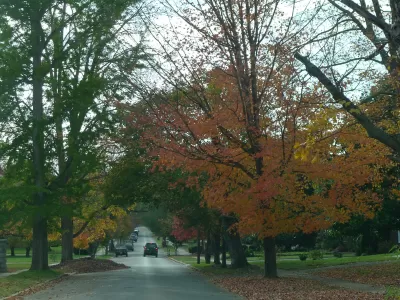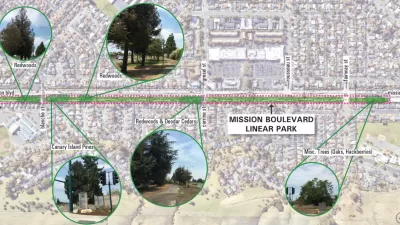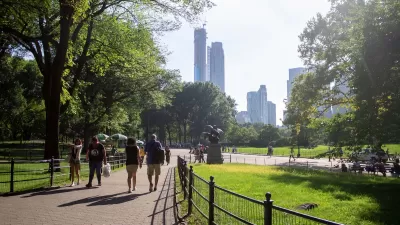A new study shows that regular exposure to trees and green spaces has a powerful impact on depression and mental health.

In a piece for The Guardian, Ashley Stimpson reports on new research that shows the importance of tree cover in urban neighborhoods and draws attention to the "tree inequity" that plagues many low-income communities.
"In many cities, a map of urban tree cover reflects the geography of race and income," Stimpson writes. Historic redlining, blamed for housing inequities and disinvestment, also has a significant impact on a neighborhood's trees—or lack thereof. "According to the US Forest Service, previously redlined areas have an average of 23% tree cover, while once-greenlined neighborhoods, living up to their old label, have an average of 43% tree cover."
Trees aren't just about aesthetics: studies show that they mitigate the urban heat island effect and boost residents' physical and mental health. "Summer days in East Baltimore neighborhoods," which are predominantly Black, historically redlined, and lack extensive tree cover, "can be four to 16 degrees hotter than other parts of the city." In such neighborhoods, residents face the risk of heat-related illnesses, higher cooling costs, and poorer air quality.
Now, research is zeroing in on the mental health effects of city trees. Using "the correlation between prescription antidepressants and tree cover across a range of neighborhoods," a group of researchers in Germany "were able to demonstrate in more material terms than ever before the correlation between trees and mental wellness." Their findings show that having trees within 100 meters of one's home is associated with reduced antidepressant use, a relationship "especially pronounced in residents with low socioeconomic status." The study's authors suggests that "'unintentional' everyday contact" with nature and "easily accessible urban green space" can have a noticeable positive impact on public health.
FULL STORY: Green health: a tree-filled street can positively influence depression, study finds

Study: Maui’s Plan to Convert Vacation Rentals to Long-Term Housing Could Cause Nearly $1 Billion Economic Loss
The plan would reduce visitor accommodation by 25,% resulting in 1,900 jobs lost.

North Texas Transit Leaders Tout Benefits of TOD for Growing Region
At a summit focused on transit-oriented development, policymakers discussed how North Texas’ expanded light rail system can serve as a tool for economic growth.

Why Should We Subsidize Public Transportation?
Many public transit agencies face financial stress due to rising costs, declining fare revenue, and declining subsidies. Transit advocates must provide a strong business case for increasing public transit funding.

How to Make US Trains Faster
Changes to boarding platforms and a switch to electric trains could improve U.S. passenger rail service without the added cost of high-speed rail.

Columbia’s Revitalized ‘Loop’ Is a Hub for Local Entrepreneurs
A focus on small businesses is helping a commercial corridor in Columbia, Missouri thrive.

Invasive Insect Threatens Minnesota’s Ash Forests
The Emerald Ash Borer is a rapidly spreading invasive pest threatening Minnesota’s ash trees, and homeowners are encouraged to plant diverse replacement species, avoid moving ash firewood, and monitor for signs of infestation.
Urban Design for Planners 1: Software Tools
This six-course series explores essential urban design concepts using open source software and equips planners with the tools they need to participate fully in the urban design process.
Planning for Universal Design
Learn the tools for implementing Universal Design in planning regulations.
Ascent Environmental
Borough of Carlisle
Institute for Housing and Urban Development Studies (IHS)
City of Grandview
Harvard GSD Executive Education
Toledo-Lucas County Plan Commissions
Salt Lake City
NYU Wagner Graduate School of Public Service





























